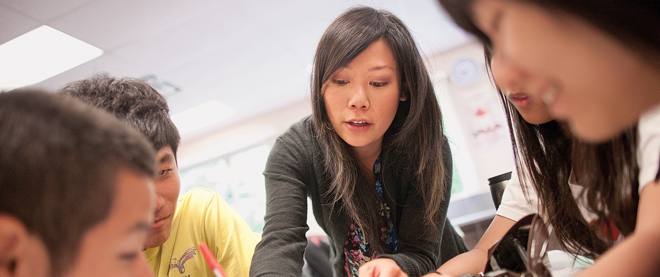Cashing in on foreign students
Public schools that recruit high-paying international students create, some say, a two-tier system
SIMON HAYTER for MACLEAN’S MAGAZINE
Share

Last year, Patricia Gartland, who works for a suburban Vancouver school district, brought in $16 million selling 1,700 B.C. classroom spots to foreign students, largely from China and South Korea. Gartland, who started her job as director of international education with the Coquitlam School District in suburban Vancouver over 10 years ago, has made the program in Vancouver one of the most extensive in Canada and the envy of the scores of districts across the country looking to cash in on the growing market for international students.
With international students paying $10,000 to $14,000 to attend Canadian schools, public school administrators across the country are setting up for-profit international student programs to compete for their dollars. One 2009 study estimated some 35,000 foreign students in the K-12 system contribute almost $700 million annually to the Canadian economy—a win-win for students, who get an invaluable leg-up when applying to North American post-secondary schools, as well as district administrators, who make up to 50 per cent profit on the tuition.
International student programs aren’t new to Canada, but at the K-12 level they’re rarely talked about, although most provinces have had programs for at least a decade. No province has been more successful at bringing in international students than B.C., with some 9,000. Capitalizing on the demand for a Western diploma and an English-language education, B.C. schools compete with Britain, the U.S. and Australia to recruit students overseas. School districts send staff abroad to meet foreign school officials and to attend trade shows. Domestically, the districts liaise with the Lower Mainland’s tight-knit Chinese and Korean communities, looking for overseas relatives. Once in Canada, the students live with extended family or billets. The students are offered supplementary language classes in tandem with regular studies, though eventually most opt for the standard curriculum.
B.C. has offered an international student program since the ’80s, but recruitment intensified after 2001, according to the British Columbia Teachers’ Federation, when the government made cuts to the education system. “School boards were short $275 million,” says BCTF president Susan Lambert. New legislation, she says, “encouraged them to find alternative sources of funding.” In 2002, Gordon Campbell’s Liberal government passed the School Amendment Act; the bill, seen by some academic experts as a move to embrace a marketized version of public education, cast school districts as business corporations, they say, and parents and students as consumers. By 2007-08, international student enrolment in B.C. peaked at 9,500 students, with an associated revenue of $129 million. But critics say that what’s emerging is a two-tier public education system that punishes the districts that need the most help.
Larry Kuehn, research director at BCTF, reports international student programs exacerbate existing inequalities in the public system by making the richest districts—those that can afford to invest in overseas recruitment—richer, and leaving poorer districts in the dust. Ultimately, says Kuehn, the programs are outside equalization factors in the provincial funding system built to circumvent such wealth disparity. Take Coquitlam, Gartland’s school board, where international student money has kept enrolment high and schools open, and afforded new development opportunities for staff and “very robust” student services, including a Confucius classroom and the first bilingual Mandarin kindergarten class in the province. “I’m wondering at the irony of an education system that says if you’re a for-profit school we’re not going to give you any funding at all but as a public school we’re going to allow you to sell to foreigners,” says Peter Cowley, education policy researcher at the Fraser Institute. “We have seen school districts in B.C. establishing for-profit companies.”
The B.C. Ministry of Education, however, rejects the notion that district inequality is an issue. “Each district has the choice of whether to offer such programs,” wrote B.C. Education Minister George Abbott in an email to Maclean’s. “Our school districts have both the autonomy and the responsibility for international student programs.”
So the districts that can recruit international students hope to emulate Coquitlam or West Vancouver, where foreign students bring in the equivalent of 16.4 per cent of its operating budget. It may not be the traditional portrait of public education, but it could be the future. In Ontario, for example, the number of international secondary students increased by six per cent between 2007-08 and 2009-10.
Back in Coquitlam, Gartland is developing student markets outside of Asia. But for now, she’s sanguine. “Suddenly everyone understands all the great benefits of this,” says Gartland. “Our mayor of Coquitlam says our program is bigger than the casino.”